New Zealand… clean, green and calm. Two large islands, 14 National Parks, thousands of beautiful landscapes, a few million sheep, Pacific Ocean around… and among all that a few thousand of Polish people living here permanently. How did they get here?
In XX century there have a few waves of Polish emigration to New Zealand.
Pahiatua Children. The year was 1944. New Zealand Government accepts a group of 733 Polish children, orphaned by the Siberian exiles from, what was previously, territory of USSR. Those children arrived in this foreign and unknown land by the war ship, and were housed in specially built camp, in a little village, called Pahiatua. From then on they have been commonly known as Pahiatua children. After the war some returned to Poland to join their distant families, however a large group of them, with no relatives left, was adopted by New Zealand families and remained here for the rest of their lives. Additionally to this group of emigrants from that time, there have been a number of Polish war veterans, who, for one reason or another, were unable to return to Poland after the war and remained abroad. Those were the emigrants, who formed first Polish communities around New Zealand, pioneering little Poland at this end of the world. They built Polish Community Houses, contributed in establishing of Polish parishes etc. Their descendants, often with lesser knowledge of Polish language, also got involved in fostering of Polish tradition and culture.
So called Solidarity Emigration. Time of 1980ties. August events caused a large waive of Polish emigration to many western countries in Europe and beyond, New Zealand included. They began their life in exile in refugee camps in Western Europe. Being mainly in a productive age, educated, with well established family life, they decided, often over night, to emigrate due to unstable situation. This emigration was in many cases of the unknown nature… This wave of Polish emigrants to New Zealand established Polish schools for their children, Polish folklore groups and cultivated Polish traditions.
New Emigration. The influx of Polish emigrants to New Zealand in the last 2 decades can be called free emigration. There are usually well educated, with good command of English young people, whose emigration to New Zealand is a well informed choice; who entered the country with either work visa or the lawful right to residence based on one of the current immigration categories or who decided to move to New Zealand from another (different to Poland) country of residence. Those Poles quickly did adjust to their new environment, bringing (based on the willingness) a lot of positive values to Polish communities here.
One can meet a Pole, or a person with Polish sounding surname, in almost every corner of New Zealand. They are spread around both islands, South and North, with greater numbers in Auckland, Wellington (capitol), Christchurch and Dunedin. Those are the main centers which have well established Polish Associations and Societies, cultivating Polish history, culture and traditions, attracting fellow countryman, who found themselves in NZ in different situations, with different motivations, in different ways, by choices of their own or brought upon them by different life circumstances. Those variations divide them… but what do they have in common?
Maybe it is the longing for homeland, for red poppies, for taste of purple plum or smell of lilac in May? Perhaps the common thing is the surrounding reality turned upside down, where Christmas occurs in the summer and skiing is in season in July? Maybe it is the tradition of awaiting the first star on Christmas Eve when the full sun is shining outside and flowers blossom in the garden? Maybe…
No matter what the differences and things in common, whatever longings and opinions, Polish people in New Zealand are simply Poles living in the beautiful part of the world where sun rises before anywhere else in the world. So far away and so close at the same time…
photos from private archive:
New Zealand, South Alps, with the highest Cook Mountain (3754 m above the sea level).


